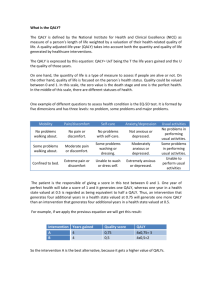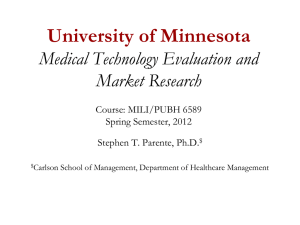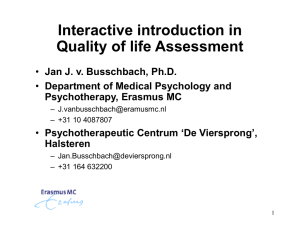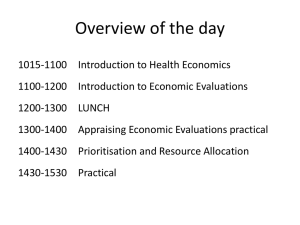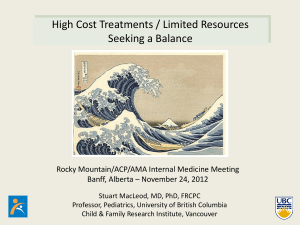Expensive New Drugs: Are They Worth It?
advertisement
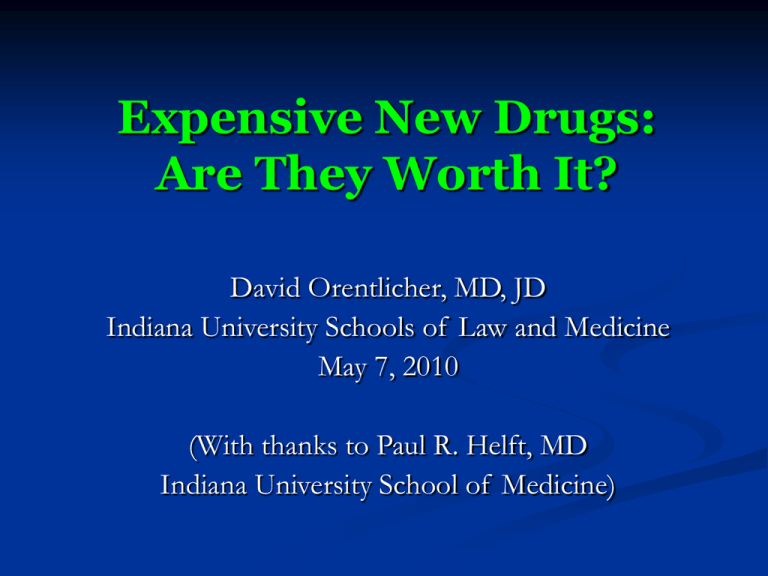
Expensive New Drugs: Are They Worth It? David Orentlicher, MD, JD Indiana University Schools of Law and Medicine May 7, 2010 (With thanks to Paul R. Helft, MD Indiana University School of Medicine) Cancer treatment as a particular area of concern Cancer treatment in the US cost more than $90 billion in 2006 Just under 5% of total US spending on medical care From 1990 to 2008, overall costs of treating cancer more than tripled in nominal dollars and more than doubled in inflation-adjusted dollars Elkin and Bach. Cancer’s Next Frontier: Addressing High and Increasing Costs. JAMA 2010;303:1086-1087. Nominal and Inflation-Adjusted Direct Medical Spending Attributed to Cancer, 1990-2009 Elkin and Bach. Cancer’s Next Frontier: Addressing High and Increasing Costs. JAMA 2010;303:1086-1087. Copyright restrictions may apply. Cost of treatment for metastatic colon cancer (Schrag D. NEJM. 2004;351:317-319) Reasons for increasing costs of cancer treatment Overall increase in spending for cancer care reflects increases in both price and quantity of care Between 1991 and 2002, the proportion of breast cancer patients receiving chemotherapy and the average cost of the chemotherapy both roughly doubled. Similar trends have been observed for other types of cancer. The increases in price and quantity reflect the introduction of new medical technology Newer cancer therapies are more expensive than the prior standard of care; they also expand the pool of treatment candidates (e.g., because of broader indications, reduced side effects). Elkin and Bach. Cancer’s Next Frontier: Addressing High and Increasing Costs. JAMA 2010;303:1086-1087. Pharmaceutical cost increases also raise concerns Spending on drugs rose from $40.3 billion in 1990 to $216 billion in 2006 (more than a three-fold increase in real dollars) Drug spending about 10 percent of total health care expenditures but has been growing faster than costs for physicians’ services or hospital care Kaiser Family Foundation, Prescription Drug Trends, September 2008, www.kff.org/rxdrugs/upload/3057_07.pdf What drives increased spending on pharmaceuticals? Number of prescriptions dispensed (42%) Types of prescriptions (34%) Average prescriptions per capita increased from 7.9 to 12.4 between 1994 and 2006 newer, higher-priced drugs replacing older, lessexpensive drugs Manufacturer price increases for existing drugs (25%) Kaiser Family Foundation, Prescription Drug Trends. May 2007 and October 2004, http://www.kff.org/rxdrugs/upload/3057_06.pdf; http://www.kff.org/rxdrugs/upload/Prescription-Drug-Trends-October-2004-UPDATE.pdf Is increased spending on drugs bad? Prescription drugs can treat—or prevent—serious illnesses But there is considerable over-prescribing—many people receive Consider, for example, statins to lower cholesterol and the risk of heart attacks, insulin to control blood sugar Prescriptions when they don’t need a drug (e.g., methylphenidate) A brand-name drug when a generic could be taken, An expensive drug when a less expensive alternative would work as well (e.g., esomeprazole for heartburn), or A very costly drug that provides little benefit (? bevacizumab) Covering very expensive drugs may be done for only some, and at the same time divert limited funds from more effective health care, particularly for the poor Can we afford these drugs? Bevacizumab (Avastin) (monoclonal antibody to block blood vessel growth) = $4,000-$9,000/month Cetuximab (Erbitux) (monoclonal antibody to block cell growth) = $17,000/month For treating non-Hodgkin’s lymphoma SIR-Spheres (radioactive microspheres) = $14,000/dose, with an overall cost = $150,000? For treating metastatic colon cancer; also head and neck cancer Ibritumomab (Zevalin) (monoclonal antibody that binds a radioactive isotope) = $24,000/month For treating metastatic colon cancer; also lung and breast cancer For treating liver metastases from colon cancer Depends on their benefit—commonly measured in QALYs QALYs QALY = quality adjusted life year A treatment provides one QALY if it prolongs life for one additional year in perfect health A treatment provides 10 QALYs if it provides 10 extra years of life in perfect health or if it provides 20 extra years of life at a quality of life that’s half that of perfect health Allows comparison of treatments for different medical problems (e.g., hemodialysis and coronary artery bypass surgery) Cost-effectiveness can be measured by calculating how much it costs per QALY of benefit for a particular treatment When is a treatment cost-effective? “Expensive” more than $100,000/QALY NICE rarely accepts above $45,000 “Reasonable” up to $50,000/QALY NICE may accept up to $45,000 “Very Efficient” less than $25,000/QALY Steinbrook R, NEJM. 359;19:1977-1981 NICE accepts when no more than $30,000 Most writers use $50-100,000 as upper limit of good value, but public preferences suggest upper limit over $250,000 Hirth RA, et al., Medical Decision Making. 2000;20:332342 Some sample QALYs (2002 dollars) Harvard Public Health Review (Fall 2004) < $0 (If the cost per QALY is less than zero, the intervention actually saves money) Flu vaccine for the elderly Under $10,000 Beta-blocker drugs post-heart attack in high-risk patients $10,000 to $20,000 Combination antiretroviral therapy for certain patients infected with the AIDS virus $15,000 to $20,000 Colonoscopy every five to 10 years for women age 50 and up $20,000 to $50,000 Antihypertensive medications in adults age 35-64 with high blood pressure but no coronary heart disease Lung transplant in UK (Anyanwu AC et al. J Thorac Cardiovasc Surg 2002;123:411-420) $50,000-$100,000 Dialysis for patients with end-stage kidney disease Antibiotic prophylaxis during dental procedures for persons at moderate to high risk of bacterial endocarditis ($88,000) (Med Decis Making. 2005;25(3):308-20) Over $500,000 CT and MRI scans for children with headache and an intermediate risk of brain tumor COST/QALY: Selected Medicare services Condition/Treatment Cost per QALY Treatment for Erectile Dysfunction $6,400/QALY *Physician Counseling for Smoking $7,200/QALY Total Hip Replacement $9,900/QALY *Outreach for Flu and Pneumonia $13,000/QALY Treatment of Major Depression $20,000/QALY Gastric Bypass Surgery $20,000/QALY Treatment for Osteoporosis $38,000/QALY *Screening For Colon Cancer $40,000/QALY Implantable Cardioverter Defibrillator $75,000/QALY Lung-Volume Reduction Surgery $98,000/QALY Tight Control of Diabetes $154,000/QALY *Treating Elevated Cholesterol ( + 1 risk factor) $200,000/QALY Resuscitation After Cardiac Arrest $270,000/QALY Left Ventricular Assist Device $900,000/QALY The example of bevacizumab 2007 sales of $2.3 billion in US ($3.5 billion worldwide) to treat about 100,000 patients with advanced lung, colon or breast cancer Genentech price: $4,000-$9,000 a month Cost to private insurers: As high as $100,000 a year NY Times, July 6, 2008 What’s the benefit? Phase III trial of bevacizumab in metastatic colon cancer 100 • Median survival: 15.6 vs 20.3 mo (HR=0.66, P<0.001) • Error bars represent 95% confidence intervals Percent surviving 80 Median survival benefit: 4.7 months or 30% increase 60 40 Treatment Group 20 IFL + placebo (n=411) IFL + Avastin (n=402) 0 0 6 12 18 Duration of survival (mo) Hurwitz H, et al. N Eng J Med. 2004;350:2335-2342 24 30 Examining the cost and cost-effectiveness of adding bevacizumab to chemo in metastatic colon cancer Randomized trial compared chemotherapy alone vs. chemotherapy + bevacizumab Bevacizumab regimen prolonged median survival from 15.6 to 20.3 months (p<0.001) Cost of extra 4.7 months? $101,500 (assuming $5,000 per month for bevacizumab) $259,149 per year of life gained (not quality adjusted) Other studies have found a cost per QALY between $143,000 and $171,000 for bevacizumab Howard DH, et al. Arch Intern Med 2010;170:537-542 NICE decided not to recommend for NHS coverage Examining the cost and cost-effectiveness of adding bevacizumab to chemo in advanced non-small cell lung cancer Randomized trial compared chemotherapy alone vs. chemotherapy + bevacizumab Bevacizumab regimen prolonged median survival from 10.2 to 12.5 months (p=0.007) Cost of extra 2.3 months? $66,270-$80,343 $345,762 per year of life gained (assuming $66,270 cost) Grusenmeyer PA, Gralla RJ. J. Clin. Oncology. 2006;24(18S):6057. Do oncologists believe bevacizumab offers good value? Survey of 139 academic med oncologists at two hospitals in Boston; 90 responded (65% of sample) Designed to estimate cost-effectiveness of bevacizumab. Participants asked: How much of a survival benefit would be needed to justify a drug that costs $70,000 a year more than standard therapy? Does bevacizumab offer “good value” for the money? Mean implied cost-effectiveness threshold for bevacizumab was $320,000/QALY (median at $280,000). Only 25 percent of the oncologists thought bevacizumab provides a good value—those who thought it did not provide good value tended to underestimate survival benefit or overestimate costs Nadler E, Eckert B, Neumann PJ. The Oncologist 2006;11:90-95 Do patients believe bevacizumab offers good value? Study of willingness to pay and consumer value for five high-cost drugs Bevacizumab, trastuzumab, rituximab, imatinib-mesylate, erlotinib A 25 percent reduction in out-of-pocket costs to patients increases by 5 percent the likelihood that patients will initiate treatment Value to the patients was four times the total cost to patients and insurers of the drugs. However, the valuecost ratio was lower for the oral drugs (for which cost sharing is lower and for which the ratio was less than one for more than half of the patients) Goldman DP et al., Health Sciences Res. 2010;45:115-132 Is it cost-effective to add erlotinib to gemcitabine in advanced pancreatic cancer? Cost effectiveness analysis of erlotinib in pancreatic cancer Study enrolled 569 patients and compared gemcitabine alone versus gemcitabine plus erlotinib Median survival improved from 6.0 to 6.4 months Cost of extra 0.4 months? Erlotinib adds $16,613 retail for six months or $498,379 per year of life gained ($332,252 per year of life gained for a 4 month course of therapy) Grubbs SS et al., J. Clin. Oncology. 2006;24(18S):6048 Cost-effectiveness analysis of trastuzumab in the adjuvant setting for treatment of HER2+ breast cancer Trastuzumab (a monoclonal antibody) associated with a 52% reduction in disease recurrence and 33% reduction in death. Romond EH, et al. NEJM. 2005;353:1673-1684. Over a lifetime, cost per QALY $27,800 (range $18-39,000) Garrison LP et al. J Clin Oncology. 2006;24(18S):6023 Expensive new drugs and the poor Cost pressures are similar for privately insured and publicly insured (or uninsured), but the pressures are accentuated with the poor Program and personal budgets are tighter Trade-offs are more tangible—when a state’s Medicaid budget rises, spending on other public services (e.g., schools) may decline, and this can pit poor against other taxpayers Growth in Medicaid spending (Medicaid expenditures as percentage of total state spending) 1987 1997 2007 Iowa Indiana Ohio Illinois New York 5.0 10.7 10.6 10.1 16.6 13.4 17.6 20.8 23.7 33.4 16.7 21.4 25.9 28.4 28.7 All States 9.8 20.0 21.1 Medicaid expenditures ($ billions) for outpatient prescription drugs 30 25 20 15 10 5 0 1991 1993 1995 1997 1999 2001 In 2003, Medicaid spent $33.7 billion on drugs (19% of national spending for drugs and more than 10% of the Medicaid budget). Expensive new drugs and the poor Difficult to protect the poor when it’s only the poor whose interests are at stake Political decisions driven by interest group advocacy, and the poor often fare poorly in such a system (but sometimes their interests coincide with those of more effective advocates—see formulary restrictions) Need to link the fortunes of the poor to those of others (Medicaid versus Medicare) and need other systemic reforms to address the wasteful spending problems Impact of 2010 health care legislation Health care disparities should be narrowed because of expanded access to care. However, The maintenance of a multi-tiered system will preserve a good deal of the disparity between rich and poor. Most of the newly-insured poor will receive coverage through Medicaid Not enough done to counteract the incentives for inefficient spending on health care Still largely maintains the fee-for-service model Need to reduce over-prescribing Important social pressures The identifiable victim versus saving statistical lives (low osmolar contrast media and the Canadian experience) Physician relationships with industry (consulting fees for opinion leaders) Physician reimbursement (more generous reimbursement leads to more costly regimens for metastatic cancer) Patient desire for a prescription (direct-to-consumer advertising and cyclyooxygenase-2-inhibitors (coxibs) for arthritis (e.g., rofecoxib)) Counter-regulation is critical (e.g., preferred drug lists, global budgets), but some regulations cause more harm than good (e.g., prescription caps) QALYs Major stroke 0 1 Perfect health Dead Recurrent stroke Writing a grant proposal
